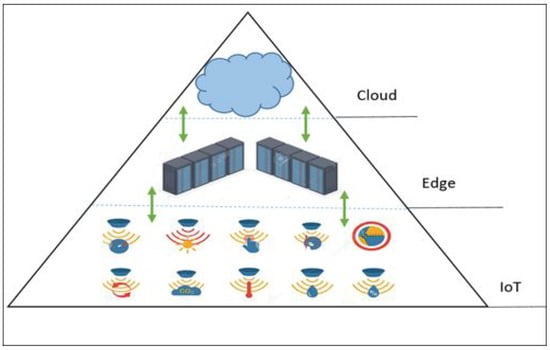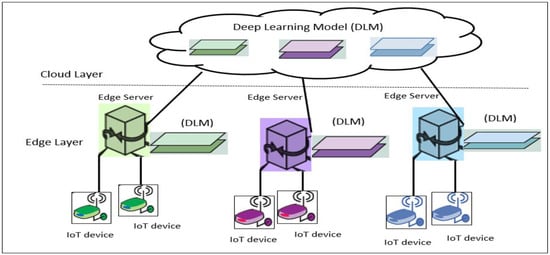You're using an outdated browser. Please upgrade to a modern browser for the best experience.
Please note this is a comparison between Version 1 by Wendy Wu and Version 2 by Sirius Huang.
Internet of Things (IoT) connects various industrial actuators, devices, and people at work. IoT provide additional insight into industrial applications, as well as minimize human labour and time and create a path for Industry 4.0.
- edge-cloud computing
- water quality
- data analysis
- WDS
- classifications
1. Introduction
Internet of Things (IoT) connects various industrial actuators, devices, and people at work. IoT provide additional insight into industrial applications, as well as minimize human labour and time and create a path for Industry 4.0. [1][2][1,2]. Artificial intelligence (AI) technologies are used in the IoT to process and analyse data from various sources and perform advanced predictive analytics such as predictive maintenance, fault class prediction, and demand forecasting [3]. It is challenging to create an accurate mathematical model for intelligent IoT applications since they are an enormous connected and complex process that produces a large volume of multi-feature data [4]. However, AI algorithms can extract critical information without needing a thorough knowledge of the underlying physical structure of the system. As a result, AI algorithms are well-suited to IoT in terms of self-adaptation, and self-learning [5]. AI technologies play a crucial role in IoT because of the highly dynamic system state and data structure and the time-varying monitoring parameters [6]. In the IoT, for example, predictive maintenance uses machine learning to detect abnormalities in systems and then anticipate device failure by correlating and evaluating the change in the pattern [7]. IoT devices, such as sensors, are of limited computation resources, hence, they have been mainly used for data collection which includes monitoring and transmitting data to robust systems such as cloud-based or centralised, for storage and processing [8]. Thus, a common IoT data analysis processing occurs at the cloud then communicating the findings to IoT devices for informed decision. Typically, data from sensor data are transported tens of thousands of kilometres to a data centre where they are stored and analysed. This approach increases data transfer latencies as well as network traffic as IoT devices have limited computation capabilities, the computation of data analytics cannot be conducted entirely on the devices [9]. As a result, bringing intelligence to the edge is without doubt a potential development trend. Integrating edge and cloud computing offers the promise to minimise IoT network traffic and related delay while enabling complex data analytics operations to be performed [10][11][12][10,11,12].
The widespread use of Internet of Things and robust cloud services has contributed to the demand for edge computing, in which data processing takes place in part at the network edge rather than entirely in the cloud [13]. Edge computing helps to solve issues such as bandwidth costs, latency, power consumption of mobile devices, security and privacy. Edge computing uses small data centres on the network’s edge to deliver distributed computing services and it acts as a middle interface between a cloud server and IoT devices/sensors [14][15][14,15]. In edge computing, the cloud takes data from the collected databases, as it has historically done, as well as from sensing devices and smartphones. The devices serve as both data consumers and data generators. As a result, queries between end devices and the cloud can be bidirectional, rather than merely from end devices to the cloud. To minimise traffic from devices to the cloud, nodes at the network edge perform a variety of computational functions, including data processing, device management, caching, and privacy protection (see Figure 1). Edge computing, in contrast to mobile cloud computing, allows for real-time data analytics while maintaining privacy, expands network capabilities, and avoids congestion in backbone networks and the internet core [16][17][16,17].

Figure 1.
Data analytics using edge computing.
2. Edge Intelligent with IoT
This section introduces the architecture of edge intelligence in IoT and presents deep learning at the edge for different IoT applications.
2.1. Cloud-Edge Intelligent Architecture
Cloud is a centralised infrastructure system that stores data, executes business models, and performs data analytics activities at a long distance away from data sources and end-users [18]. However, with large-scale traffic and a proliferation of connected devices, it is neither feasible nor feasible to transmit all data to the cloud for processing. Edge computing has arisen as a means of addressing these issues by shifting processing to the network’s and data sources’ edges [19][20][19,20]. Edge computing and fog computing share similar characteristics. Sometimes, the terms “fog” and “edge” are commonly used to describe the same thing [21]; but the difference is that edge computing is primarily focused on nodes that are closer to IoT devices, while fog computing may encompass any resource that is situated anywhere between the end device and cloud [22]. Herein, the word “edge” refers to compute nodes that are near the water network edge, such as edge servers [23]. Even though edge computing reduces traffic, the computer resources accessible on the edge do not have the same capabilities as those available in the cloud. As a result, computationally intensive processes like machine learning are not well suited to edge devices. However, the edge can enhance cloud computing by performing a portion of the computation, lowering network traffic and latency [24].
As illustrated in Figure 2, the edge-cloud learning framework is made up of three primary components: end-user devices, edge learning servers, and remote cloud deep learning clusters [25]. End-user devices, such as mobile phones, cameras, and internet-of-things sensors, send data to the edge server, which can be noisy and highly redundant [26]. Edge computing servers collect enormous amounts of raw data from end-users and utilize pre-processing and basic learning algorithms to filter out the noise and extract significant features from the raw data. Deep learning tasks, such as convolutional neural networks (CNN) and artificial neural networks (ANN), are carried out by the deep learning cluster (cloud), which is outfitted with scalable and robust GPU resources [27].

Figure 2.
Standard edge-cloud architecture.

2.2. Deep Learning in Edge Computing
Typically, IoT devices generate significant amounts of data and send it to the cloud for processing. These data include multimedia information like photos, sounds, videos, and structured data like vibration, temperature, and humidity. There are numerous developed solutions for analysing structured data and then operating IoT devices autonomously [28]. Deep learning has been successful in many fields, including multiple visual tasks, speech recognition, natural language processing and industrial applications [29], this is because of its capacity to learn complicated models, and diversity of architectures [30]. A deep learning network is often composed of numerous layers. These layers will process the input data. Each layer processes the previous layer’s intermediate features and then generates new features. Finally, the extracted features generated by the final deep learning network layer will be recognised as the output by a classifier. Deep learning networks consider the layers closest to the input data to be lower levels, while the others are higher layers [28][31][28,31].
Researchers have used an MLP model to detect and classify water contaminant levels for data that include water quality parameters. The developed model contains several layers that are completely connected. The model was trained using time series data for more than 50,000 samples. The MLP model was used to classify the data into five different classes representing the various levels of water contamination. Deep learning increases prediction accuracy for IoT services by extracting features through numerous layers rather than traditional complex pre-processing. However, with increased accuracy, communication performance will be the bottleneck. The amount of data needed to train deep-learning models is huge. Such a large volume of network traffic can cause various changes to the network in terms of increasing transmission delay, reducing the packet delivery ratio, increasing energy consumption due to high transmission rate, and may pose security risks; therefore, typical cloud-based solutions for deep learning approaches on IoT may not be ideal [32].
Figure 3 presents an edge computing topology for IoT deep learning applications. The structure is composed of two layers and also a normal edge computing structure. Edge servers are placed at the edge to process gathered data and the cloud server is used to train the deep learning network [33]. Applying deep learning entirely at the edge will reduce network traffic. However, the capacity of edge servers is limited compared to cloud servers. It is impossible to process infinite tasks in edge servers. Dedicating the entire work of deep learning to the edge will bring additional computing overhead to the servers. Therefore, we can only deploy part of the deep learning network into edge servers. The issue is deciding how to partition each deep learning network.

Figure 3.
Deep learning in edge computing.
